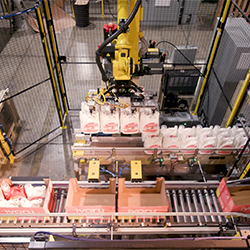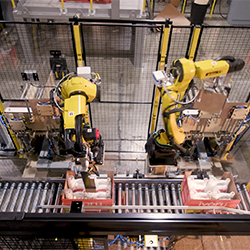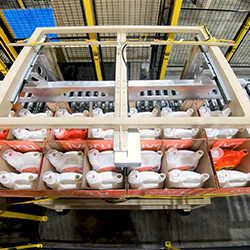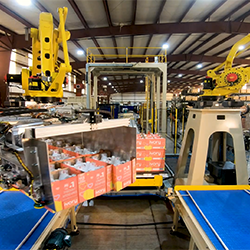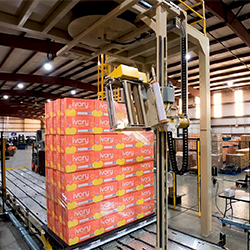KPac and KPal C Robotic Case Packing and Clamp Palletizing System with KForce Stretch Wrapper
Kaufman built the custom robotic packing, palletizing, and stretch wrapping system featured in the case study below utilizing FANUC robots. The system was designed and built with the customer's specific requirements in mind.
To get information on what Kaufman Engineered Systems can do for you, contact us today!
THE CHALLENGE:
The customer for this project is a global leader in the container and recycling industry. One of the many products they create for their own customers is various sizes of laundry detergent containers from start to finish, so there are many systems and processes being used to create the bottles, trim them, put a fill spout on each, put a dosing cap on each, etc. Once the bottles are made, they need to be packed into cases, palletized, and stretch wrapped into secure loads. This is where Kaufman comes in. We needed to design and build them a system that would run 150-ounce, 154-ounce, and 170-ounce plastic bottles, one size at a time, with a changeover process that would be simple and efficient.
THE SOLUTION:
We built the system to have two parallel feeds to match the upstream blow molding process. Each side of our system receives bottles and feeds them through a 1-to-2 pneumatic laner where the bottles come into one lane and are conveyed a short way before they are split into two lanes. After the bottles are split into two lanes, bottles are staged two bottles wide by four bottles long to be picked and placed by a robot into a 4-pack case. The case packing process effectively packs two 4-pack boxes at a time and can pack either cases or cases without lids (called trays).
The trays then move on to the divider inserter section, where two robots place a piece of corrugate in the middle of each tray between the bottles to improve the stability of the trays as they are stacked.
The next part of the system is the Bundle Forming Unit (BFU). This part of the system actually gets faster as we design each process to keep the upstream process from stopping. This section also folds the case major flaps over and interlocks them for cases that require this. The BFU section of the system is also where the cases get pushed into the pattern required for the palletizer robots to pick up and place products onto the pallet - in this instance, the system creates three columns of four cases per column with twelve cases ready to be picked up and placed onto the pallet. This part of the system needs to ability to operate faster to accommodate a surge rate that includes picking the pallet, picking and placing cases, as well as top sheets to complete each 8-layer pallet in well under four minutes.
Nominally, the system will run at 6 minutes per pallet, but KES designs systems so that they have enough capacity to handle a 15-20% surge rate. To make this happen, this system needed to be built with the ability to accumulate bottles, cases, and pallets in between various processes, so there would rarely be a reason to STOP the process. The desire is for the system to operate continuously, and if there is a stop/start, there is enough accumulation not to stop the upstream or downstream processes.
Once the pallet load is built, it conveys on a pallet conveyor to the KForce stretch wrapper. We used a chain conveyor for the pallet conveyor in this system for unit load stability. Using other conveyor types, such as a roller conveyor on heavy and high loads like this, can cause loads to wobble when damaged pallets are in play. We had to pick the right pallet conveyor based on the application, and this one required more stability.
Finally, for the stretch wrapper piece of this system, we built a load lifter to lift each load during the stretch wrapping process so that the stretch wrap head can reach all the way to the bottom of the pallet. This ensures the pallet is securely wrapped from the top of the load to the bottom of the pallet.
Contact Us ---- JOIN OUR MAILING LIST ---- Request Quote

